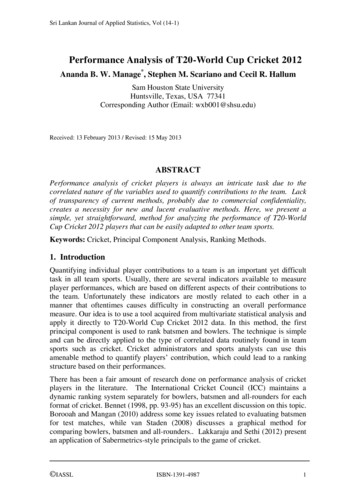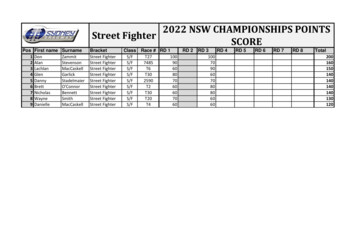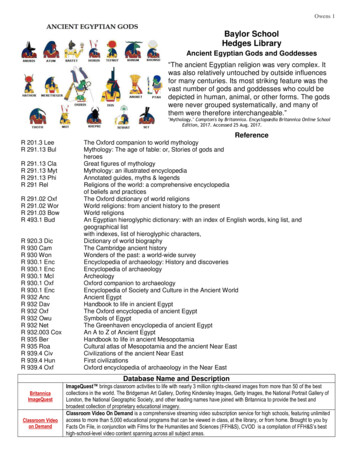
Transcription
Sri Lankan Journal of Applied Statistics, Vol (14-1)Performance Analysis of T20-World Cup Cricket 2012Ananda B. W. Manage*, Stephen M. Scariano and Cecil R. HallumSam Houston State UniversityHuntsville, Texas, USA 77341Corresponding Author (Email: wxb001@shsu.edu)Received: 13 February 2013 / Revised: 15 May 2013ABSTRACTPerformance analysis of cricket players is always an intricate task due to thecorrelated nature of the variables used to quantify contributions to the team. Lackof transparency of current methods, probably due to commercial confidentiality,creates a necessity for new and lucent evaluative methods. Here, we present asimple, yet straightforward, method for analyzing the performance of T20-WorldCup Cricket 2012 players that can be easily adapted to other team sports.Keywords: Cricket, Principal Component Analysis, Ranking Methods.1. IntroductionQuantifying individual player contributions to a team is an important yet difficulttask in all team sports. Usually, there are several indicators available to measureplayer performances, which are based on different aspects of their contributions tothe team. Unfortunately these indicators are mostly related to each other in amanner that oftentimes causes difficulty in constructing an overall performancemeasure. Our idea is to use a tool acquired from multivariate statistical analysis andapply it directly to T20-World Cup Cricket 2012 data. In this method, the firstprincipal component is used to rank batsmen and bowlers. The technique is simpleand can be directly applied to the type of correlated data routinely found in teamsports such as cricket. Cricket administrators and sports analysts can use thisamenable method to quantify players’ contribution, which could lead to a rankingstructure based on their performances.There has been a fair amount of research done on performance analysis of cricketplayers in the literature. The International Cricket Council (ICC) maintains adynamic ranking system separately for bowlers, batsmen and all-rounders for eachformat of cricket. Bennet (1998, pp. 93-95) has an excellent discussion on this topic.Borooah and Mangan (2010) address some key issues related to evaluating batsmenfor test matches, while van Staden (2008) discusses a graphical method forcomparing bowlers, batsmen and all-rounders. Lakkaraju and Sethi (2012) presentan application of Sabermetrics-style principals to the game of cricket. IASSLISBN-1391-49871
Ananda B. W. Manage, Stephen M. Scariano, and Cecil R. HallumThe general scarcity of the details regarding currently used ranking methods,probably due to commercial confidentiality, creates a need for new and readilyavailable ranking methods. In contrast, the simplicity and the openness of theproposed method would make it an attractive alternative for the cricket playingcommunity. We will compare and contrast our proposed method with the T20World Cup 2012 analysis published at ESPN at /content/story/586148.html by Madhusudhan Ramakrishnan,who is a sub-editor (stats) at ESPNcricinfo. To make the reference more compact,this ranking method is abbreviated as the “MR-ranking”.2. Ranking using the First Principal ComponentReaders can find excellent introductions to Principal Component Analysis (PCA) inthe works of Johnson and Wichern (2007), Dawkins (1989), and Watnik and Levine(2001). Nalik & Khattree (1999) provide an example in which principalcomponent analysis is used with sports data. PCA is a wide area in statisticalscience, and there are many other excellent reference sources as well.Briefly, ifcovarianceis a k-vector of random variables with varianceand corresponding eigenvalue-eigenvector pairs, where, then the principalare defined bymatrixcomponents,Furthermore, it can be shown that,,(1)Consequently, the proportion of total variability due to theis given byprincipal componentIf the first principle component captures a substantial percentage of the totalvariation in the observations, it can possibly be used to discriminate between the kvectors. Indeed, if accounts for most of the variation seen in the data, then thereis good reason to believe that it can successfully be used for ranking purposes. Forthis reason, we call this technique the First Principal Component (FPC) rankingmethod. In practice, it is customary to use the correlation matrix instead of thevariance-covariance matrix when the measurement units for the components of the2ISBN-1391-4987 IASSL
Performance Analysis of T20-World Cup Cricket 2012data vector are largely dissimilar. For this reason, the correlation matrix is usedin this analysis.3. Ranking BatsmenThe MR-ranking method uses a point system to quantify the contributions of cricketplayers. Unfortunately, the calculative method of assignment of points to a player isnot explicitly disclosed. Table 1 shows the MR-ranking for the top ten batsmen whoscored a minimum of one hundred runs in the T20-World Cup 2012. The keyvariables seen are Innings, Runs, Average, Strike Rate and Points (assigned bythe MR-ranking). For this method, Marlon Samuels is the top batsman followed byChris Gayle.Table 1: MR-ranking of Top Ten Batsmen in T20-World Cup 2012 (min 100 runs) InningsRunsAverageMarlon SamuelsChris GayleShane WatsonBrendon McCullumVirat KohliLuke WrightMahela JayawardeneRoss TaylorSuresh RainaMichael 6.9815.9015.81Although the variables shown in Table 1 are undoubtedly important ones, there areseveral other variables that carry information about the contributions to a team by abatsman, and some of the variables may, indeed, be correlated. Here, we use thecorrelation matrix to accommodate discrepancies in the magnitudes of themeasurement units of the variables. Below is a brief description of our selection forthe critical variables used to quantify the quality of batsmen.Runs: Total number of runs scored in the T20-World Cup 2012.Batting Average (Ave): Total number of runs a batsman has scored divided by thetotal number of innings in the T20-World Cup 2012 (It is only the number ofinnings where the batsman was called out). Note that this number overrates theperformance of a batsman with several “not out” cases, which is a weakness in thismeasure. IASSLISBN-1391-49873
Ananda B. W. Manage, Stephen M. Scariano, and Cecil R. HallumBatting Strike Rate (SR): The number of runs scored per 100 balls faced in theT20-World Cup 2012. Higher values of SR indicate stronger performance, as anaggressive batting style is always advantageous in shorter versions of limited-overscricket matches like T20.Fours: Total number of boundaries (fours) made in the T20-World Cup 2012.Hitting boundaries is also auspicious for winning in limited-overs cricket.Sixes: Total number of sixes made in the T20 World Cup 2012. An adroit batsmancontinually strives to hit sixes, which is a desirable characteristic of a qualitybatsman, especially in a shorter format of limited-overs cricket matches like T20.HF: Denotes the calculation (2 x Number of Centuries Number of Fifties). It isalways good to build partnerships and play longer innings in any format of cricket.In this tournament, there was only one century by New Zealand batsman BrendonMcCullum who scores 123 runs against Bangladesh. Since there was only onecentury (100 or more runs), we created the variable “HF” to include the combinedinformation carried by the total number of centuries and half-centuries (50 or moreruns but less than 100 runs in an innings).All batsmen who played at least three innings in the T20-World Cup 2012 wereincluded in this analysis, so that fifty-seven total batsmen comprise this list. Foreach batsman we collected (6 x 1) column vectors of the form (Runs, Ave, SR,Fours, Sixes, HF)’, and using them computed the sample correlation matrix withSAS 9.2. Next, we obtained all eigenvalues and associated eigenvectors for thecorrelation matrix and identified the largest eigenvalue,, as well as itscorresponding eigenvector [0.471, 0.380, 0.299, 0.402, 0.432]’. The latentvalue was the only eigenvalue exceeding 1.0 and SAS 9.2 reports that the firstprincipal componentaccounts for 66.9% of the total variability identifiedin equation (1). So, it is plausible to concentrate on just the First PrincipalComponent (FPC), as it accounts for a substantial portion of the total variability.Accordingly, we choose to rank the T20-World Cup 2012 batsmen based on theirindividual scores produces by the first principal component computation. Table 2extracts from Table 3, which provides the FPC-rankings for all 57 batsmen whoplayed at least three innings, the top ten batsmen who scored at least one hundredtotal runs along with their FPC-rankings.A glance at Table 1 and Table 2 reveals that eight out of ten players appear in both,although the rank orderings of the batsmen is slightly different. Unlike the MRrankings, the FPC-rankings capture essential statistical information about thebatsmen in a straightforward manner that can be easily checked. Here are some keydifferences in the techniques that demonstrate the superiority of the FPC method:4ISBN-1391-4987 IASSL
StrikeRate150.0Chris Gayle (2)6122244.4Marlon Samuels (1)60230Luke Wright (6)51Brendon McCullum (4)5Mahela Jayawardene (7)ISBN-1391-4987FoursSixesHFFPC .329513.02Virat Kohli (5)5118546.3122.520422.66Michael Hussey (10)5315577.5123.012412.22Imran Nazir (not in top 10)6015325.5150.024311.91Nasir Jamshed (not in top 10)6114829.6134.58821.82Performance Analysis of T20-World Cup Cricket 2012IASSLTable 2: FPC-ranking of Top Ten Batsmen in T20-World Cup 2012 (min 100 runs)NotBatsman (MR Ranking)InningsRunsAveOutShane Watson (3)6124949.85
Ananda B. W. Manage, Stephen M. Scariano, and Cecil R. HallumMarlon Samuels & Shane Watson: Marlon Samuels and Shane Watson have MRrankings 1 and 3, respectively, yet their FPC-rankings are just the opposite, 3 and 1,respectively. Watson scored 249 total runs with an average of 49.8 runs, and astrike rate of 150. He hit three half-centuries, 19 boundaries and 15 sixes. MarlonSamuels scored a total of 230 runs with an average 38.3 runs, and a strike rate of132.9. He hit three half-centuries, 14 boundaries and 15 sixes. Clearly, Watson hashigher total runs, higher strike rate and more sixes, while Samuels is not superior interms of any variables that we considered in the analysis. Therefore, Watson shouldbe ranked higher than Samuels.Suresh Raina & Nasir Jamshed: Suresh Raina is ranked ninth of the top tenbatsmen by MR-method. However, he does not appear in the top ten list of batsmenusing the FPC-rankings. Raina scored 110 total runs with an average 36.7 runs, anda strike rate of 126.4. He hit no half-centuries or centuries nor did he score anyboundaries or sixes. Now, compare Raina’s performance to that of Nasir Jamshed,whose rank is tenth in Table 2 when using the FPC method. Jamshed scored 148total runs with an average 29.6 runs, and a strike rate of 134.5. He hit two halfcenturies, scored 8 boundaries as well as 8 sixes. So, Jamshed has a better strikerate, two half-centuries, 8 sixes and 8 boundaries when compared to Raina whoscored no half-centuries or centuries and no sixes or boundaries. Therefore,Jamshed should be ranked higher than Raina. Accordingly, Riana does not appearin the top ten list of batsmen when using FPC-ranking.Virat Kohli & Luke Wright: Virat Kohli is ranked above Luke Wright in the MRrankings, but the order is reversed for the FPC-rankings. Kohli scored 185 total runswith an average 46.3 runs, and a strike rate of 122.5. He hit 2 half-centuries, andscored 20 boundaries and 4 sixes. On the other hand, Wright scored 193 total runswith an average 48.3 runs, and a strike rate of 169.3. He hit 2 half-centuries, andscored 14 boundaries and 13 sixes. In fact, Wright has a better average, strike rateand also more sixes than Kohli. The strike rate and number of sixes are extremelyimportant factors in the shorter formats of cricket like Twenty20. Therefore, Wrightshould be ranked higher than Kohli, which we see in the FPC-rankings of these twobatsmen.Ross Taylor: Ross Taylor is ranked eighth in the MR-rankings, but he does notappear in the top ten list of FCP-rankings because he ranks eleventh. The FPCranking method selects Nasir Jamshed, who is the tenth, above Taylor since hescored two half-centuries to just one half-century by Taylor.4. Ranking BowlersComparisons of MR-rankings and FPC rankings are now considered for T20-WorldCup 2012 bowlers. Table 4 shows the top ten list for the MR point system whenquantifying contributions of bowlers who bowled at least 15 overs in the T20 WorldCup 2012. Here, Ajantha Mendis, who is also the highest wicket-taker, is rankedfirst.6ISBN-1391-4987 IASSL
Performance Analysis of T20-World Cup Cricket 2012Table 3: FPC-ranking of T20-World Cup 2012 Batsmen who played at least inningsPlayerSR Watson (Aus)CH Gayle (WI)MN Samuels (WI)LJ Wright (Eng)BB McCullum (NZ)DPMD Jayawardene (SL)V Kohli (India)MEK Hussey (Aus)Imran Nazir (Pak)Nasir Jamshed (Pak)LRPL Taylor (NZ)TM Dilshan (SL)GJ Bailey (Aus)DA Warner (Aus)EJG Morgan (Eng)Umar Akmal (Pak)J Charles (WI)KC Sangakkara (SL)JEC Franklin (NZ)AD Hales (Eng)DJ Bravo (WI)Mohammad Hafeez (Pak)RJ Nicol (NZ)RG Sharma (India)SK Raina (India)JP Duminy (SA)RJ Peterson (SA)BMAJ Mendis (SL)MS Dhoni (India)AB de Villiers (SA)KA Pollard (WI)CL White (Aus)Umar Gul (Pak)RE Levi (SA)NLTC Perera (SL)DJG Sammy (WI)G Gambhir (India)Yuvraj Singh (India)AD Mathews (SL)HM Amla (SA)F Behardien (SA)MJ Guptill (NZ)JA Morkel (SA)AD Russell (WI)V Sehwag (India)Kamran Akmal (Pak)Shahid Afridi (Pak)Shoaib Malik (Pak)JC Buttler (Eng)HDRL Thirimanne (SL)NL McCullum (NZ)C Kieswetter (Eng)JM Bairstow (Eng)JDP Oram (NZ)KS Williamson (NZ)JH Kallis (SA)D Ramdin (WI) 5-2.37-2.37-2.76-2.83ISBN-1391-49877
Ananda B. W. Manage, Stephen M. Scariano, and Cecil R. HallumParalleling the scrutiny given batsmen, there are several, potentially correlated,variables that carry the information about team contributions by bowlers. Again,we use the correlation matrix to accommodate for discrepancies in the magnitudesof the measurement units of the variables. Here is a brief description of the criticalvariables used to quantify the quality of the bowlers.Wickets: The number of wickets taken. A bowler’s goal is to obtain as many aswickets as possible.Bowling Average (Ave): The average number of runs conceded per wicket. Betterbowlers have lower averages.Strike Rate (SR): The average number of balls bowled per wicket taken. Betterbowlers have lower strike rates.Economy Rate (Econ): The average number of runs conceded per over. Betterbowlers have lower economy rate.Table 4: MR-ranking of Top Ten Bowlers in T20-World Cup 2012 (min 15 overs)MatchesWicketsAverageEconomyRateMR PointsAjantha Mendis6159.806.1235.65Sunil Narine7915.445.6327.90Samuel Badree4422.255.5627.53Steve Finn5815.376.1527.22Shane Watson61116.007.3325.94Raza Hasan4324.664.9325.83Graeme Swann5716.716.1525.27Mitchell Starc61016.406.8324.64Saeed Ajmal6918.116.7923.42Dale Steyn5613.664.8223.07BowlerAll bowlers who bowled at least ten overs in the T20-World Cup 2012 wereincluded in this analysis, so that forty-one total bowlers comprise this list. For eachbowler, we collected (4 x 1) column vectors of the form (Wickets, Ave, SR,Econ)’, and using them computed the sample correlation matrix with SAS 9.2.Next, we obtained all eigenvalues and associated eigenvectors for the correlationmatrix and identified the largest eigenvalue,, as well as itscorresponding eigenvector [-0.508, 0.601, 0.205, 0.582]’. Eigenvalue wasthe only one exceeding 1.0, and SAS 9.2 reports that the first principal componentaccounts 64.7% of the total variability identified in equation (1). So, it isreasonable to focus on just the First Principal Component (FPC) since it accountsfor a pertinent amount of the total variability. Accordingly, we choose to rank theT20-World Cup 2012 bowlers based on their individual first principal componentscores. Table 6 gives the FPC-rankings for all 41 bowlers who bowled at least ten8ISBN-1391-4987 IASSL
Performance Analysis of T20-World Cup Cricket 2012overs, but for purposes of direct comparison with the MR-rankings in Table 4,Table 5 extracts from Table 6 the top ten bowlers who bowled at least fifteen oversalong with their FPC-rankings. Sri Lankan spinner Ajantha Mendis is seen to be thetop bowler for both ranking methods. Additionally, eight of ten bowlers match inTable 4 and Table 5, although the rank orderings are different. Just as with thebatsmen, the FPC-rankings capture essential statistical information about thebowlers in a genuine way that can be confirmed easily.Table 5: FPC-ranking of Top Ten Bowlers in T20 World Cup 2012 (min 15 overs)Bowler eFPCRankAjantha Mendis (1)24.0159.86.129.6-2.98Shane Watson (5)24.01116.07.3313.0-1.70Mitchell Starc (8)24.01016.46.8314.4-1.52Sunil Narine (2)24.4915.45.6316.4-1.49Steve Finn (4)20.0815.46.1515.0-1.28Saeed Ajmal (9)24.0918.16.7916.0-1.22Dale Steyn (10)17.0613.74.8217.0-1.11Graeme Swann (7)Timothy Southee(not in top 10)Ravi Rampaul (notin top 5921.07.9315.8-0.94As with the batsmen, here are some key differences in the techniques thatdemonstrate the superiority of the FPC method:Samuel Badree & Ravi Rampaul: Samuel Badree is ranked number three in theMR-rankings but does not appear in the list of top ten bowlers when using the FPCmethod. Badree bowled 16.0 overs and took 4 wickets with an average of 22.3. Hiseconomy rate is 5.56, and his strike rate is 24.0. On the other hand, Rampaul, whoranks tenth in the FPC-ranking method bowled 23.5 overs and took 9 wickets withan average of 22.0. His economy rate is 7.93, and his strike rate is 15.8. So, Badreeis better than Rampaul only with respect to the economy rate variable, which is thenumber of runs per over. It is true that a low economy rate is a desirable attribute.However, Rampaul has a lower average, which is better since it represents thenumber of runs conceded per wicket. Moreover, Rampaul has the lower strike rate,which is the average number of balls per wicket. In addition, Rampaul has taken 9wickets for 23.5 overs, while Badree has taken just 4 wickets for 16.0 overs. Thisjustifies that Rampaul should be ranked higher than Badree.Mitchell Starc: Michell Starc is ranked seventh in the MR-rankings yet rankedthird in the FPC-rankings. Starc has taken 10 wickets, which is the third highest IASSLISBN-1391-49879
Ananda B. W. Manage, Stephen M. Scariano, and Cecil R. Hallumnumber in all the tournament. His average is 16.4, economy rate is 6.83 and strikerate is 14.4, which are smaller values when compared to the top ten bowlers.Table 6: FPC-ranking of T20 World Cup 2012 Bowlers (min 10 overs)BowlerBAW Mendis (SL)L Balaji (India)Yuvraj Singh (India)SR Watson (Aus)MA Starc (Aus)SP Narine (WI)JH Kallis (SA)ST Finn (Eng)Saeed Ajmal (Pak)DW Steyn (SA)GP Swann (Eng)TG Southee (NZ)R Rampaul (WI)A Dananjaya (SL)BMAJ Mendis (SL)SCJ Broad (Eng)RJ Peterson (SA)R Ashwin (India)SL Malinga (SL)XJ Doherty (Aus)Mohammad Hafeez (Pak)M Morkel (SA)S Badree (WI)IK Pathan (India)JDP Oram (NZ)NL McCullum (NZ)KMDN Kulasekara (SL)Raza Hasan (Pak)PJ Cummins (Aus)CH Gayle (WI)AD Mathews (SL)DJG Sammy (WI)KD Mills (NZ)Z Khan (India)JW Dernbach (Eng)MN Samuels (WI)Shahid Afridi (Pak)Umar Gul (Pak)DL Vettori (NZ)GB Hogg (Aus)J Botha 10.490.550.750.760.831.011.191.452.462.524.275.63 IASSL
Performance Analysis of T20-World Cup Cricket 2012Raza Hasan: Pakistan bowler Raza Hasan is ranked number six in the MRrankings. However, Raza is not in the list of top ten bowler using the FPC method.He bowled fifteen overs and took only three wickets for the whole tournament. Hisbowling average is 24.7, which is higher than all the players in both top ten lists.Raza’s strike rate is 30.0, which is also higher than that of all the top ten bowlers inboth top ten lists. While it is true that his economy rate is lower, he did not takeenough tournament wickets, which a quality T20 bowler must do. The MR-rankingmethod appears to give too much weight to the economy rate variable withoutconsidering other informative factors, resulting in some distortion in its rankingcontext.Timothy Southee: New Zealand bowler Timothy Southee is ranked number nine inthe top ten list in FPC-rankings, but does not appear in the top ten list of the MRmethod. Timothy bowled 18 overs, took eight wickets, had an average of 18.0 withstrike rate 13.5. His economy rate is a bit higher when compared to other topplayers; however, his bowling average is lower than that of Saeed Ajmal, who isranked number nine in the MR-rankings. Also, Timothy has the third best strikerate in the whole tournament. This justifies why he is correctly ranked in the FPCrankings but not so in the MR-rankings.5. ConclusionsIn this article we have demonstrated a simple, yet straightforward, method foranalyzing the performance of T20-World Cup Cricket 2012 players. The proposedmethod, based on principal component analysis, is transparent and can be directlyapplied to the type of correlated data routinely found in cricket, as well as otherteam sports. We compared our method with the T20-World Cup 2012 analysispublished by Madhusudhan Ramakrishnan of ESPNcricinfo, and eight of the ten topbatsmen and eight of the ten top bowlers agree under both methods. Specificexamples were further studied demonstrating the superiority the FPC method. Theability of the First Principal Component method to consistently capture a significantportion of the variability in cricket athletic performance is the key strength of theproposed method, which offers a transparent alternative for the cricket-playingcommunity.References1. Bennet, J. (1998) Statistics in Sports, Oxford University Press Inc., pp 93-95.2. Borooah Vani K. and Mangan John E. (2010) "The "Bradman Class": AnExploration of Some Issues in the Evaluation of Batsmen for Test Matches,1877-2006," Journal of Quantitative Analysis in Sports: Vol. 6 : Iss. 3, Article14.3. Dawkins, B. (1989), “Multivariate Analysis of National Track Records.” TheAmerican Statistician, 43, 100-115, DOI:10.2307/2684514, DOI:10.1080/00031305.1989.10475631.4. Johnson, R. A., and Wichern, D. W. (2007), Applied Multivariate StatisticalAnalysis (6th ed.), Upper Saddle River, NJ: Prentice Hall. IASSLISBN-1391-498711
Ananda B. W. Manage, Stephen M. Scariano, and Cecil R. Hallum5. Lakkaraju, P. and S Sethi, S. (2012). Correlating the Analysis of OpinionatedTexts Using SAS Text Analytics with Application of Sabermetrics to CricketStatistics, Proceedings of SAS Global Forum 20126. Naik, D. N., and Khattree, R. (1996), “Revisiting Olympic Track Records: SomePractical Considerations in the Principal Component Analysis.” The AmericanStatistician, 50(2), 140-144,DOI: 10.2307/2684425, DOI: 10.1080/00031305.1996.104743617. Ramakrishnan, M. (2012) ” An analysis of individual batting and bowlingperformances in the World Twenty20 2012” [online]. Available 12/content/story/586148.html.8. van Staden, P. J. (2008) “Comparison of bowlers, batsmen and all-rounders incricket using graphical displays”, Technical Report 08/01, Department ofStatistics, Faculty of Natural and Agricultural Sciences, University of Pretoria.9. Watnik , M. and Levine, R A., (2001), “NFL Y2K PCA,” Journal of StatisticsEducation, 9, 3. Available at ts.watnik.html12ISBN-1391-4987 IASSL
measure. Our idea is to use a tool acquired from multivariate statistical analysis and apply it directly to T20-World Cup Cricket 2012 data. In this method, the first principal component is used to rank batsmen and bowlers. The technique is simple and can be directly applied to the type of correlated data routinely found in team










